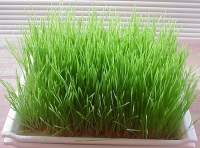From Grasses and Weeds – Why wheatgrass
While not so pleasant to the taste buds, fresh young grasses and green edible weeds have a much greater healing potential than the vegetables commonly used for juicing. In particular, they are higher in their content of life force and enzymes. Instead of working hard to maintain a big vegetable garden, I believe it to be easier and healthier to let a large part of the garden overgrow with suitable grasses and edible weeds. An additional advantage of young grasses is the short time and minimal care required to grow them as compared to growing vegetables. You can harvest grasses in two to three weeks compared to several months for vegetables.
To find out which weeds are edible, ask a knowledgeable friend or neighbour, or observe what goats and poultry are eating, or chew a bit of a leaf yourself. If it is not bitter, it is not likely to be poisonous, and anyway, there are no poisonous grasses. For a very healthy juice, use grasses, green weeds, and the petals of squash flowers; flavour with an apple, beet root, and carrot. Juice made from young and fresh blades of cereal grass is most beneficial. These young blades have the highest vitality and are rich in enzymes and growth hormones that are missing or at low levels in mature plants and leaves, as well as in elderly humans. Kirrlian photography reveals that the vitality of leaves starts to diminish soon after cutting and that most of it is lost within hours, though if refrigerated in a closed plastic bag it may be kept for a day. Most nutrients will still be available from commercially dried and powdered grass, such as green barley grass (commercially available), but young fresh grass juice has a much higher vitality. Best known is wheat grass, but I contend that all fresh, young grass grown in good soil has similar healing and rejuvenating qualities, though the flavour and toughness may differ greatly. Barley grass grows more vigorously than wheat grass and tastes good. Young Rye grass (not the cereal rye grain), grown by farmers as pasture, has a pleasant flavour and can give you several months of repeated cutting from one planting. Experiment with different varieties of grasses to see which grow best in your climate and soil conditions, and find one you like. When using lawn grass, the main requirement is that it to be grown in good soil without the use of pesticides or chemical fertilisers; preferably fence off part of the lawn for this purpose. Often there is some foam on top of the juice, especially with grass juice. This foam is high in chlorophyll and beneficial, so ingest or rub it into your skin. I find wheat grass juice somewhat too sweet on its own and prefer it blended with other grass. As barley grass does not taste sweet, it may be better than wheat grass for individuals with blood sugar problems. Normally, however, it is good to mix the seeds of wheat and barley and grow them together in the same garden bed or tray.
In cool climates, it may be difficult growing grass outside in winter, while in the tropics it is sometimes difficult in summer because it is either too hot or too wet and cereal grasses easily start rotting at the stem. In the city, it may not be possible anyway. In these circumstances, wheat grass or barley grass can be grown indoors behind a window or on a balcony or verandah in seed boxes. While grass juice provides a high amount of easily digestible protein, as well as vitamins and minerals superior quality, even more important are enzymes, growth hormones, and other vital factors, including coenzyme Q10 and superoxide dismutase (SOD). In animal experiments, old rats were rejuvenated and chickens grew 15 percent faster with fresh grass, but not with other supplements. Many patients attribute their cure from “incurable” diseases to the generous intake of grass juice. Grass juice has also been successfully used as a retention enema with cancer and other debilitating conditions, as a vaginal douche, or topical rub for the skin. Juicy grass pulp is excellent on wounds and speeds up the healing. Grass juice has been shown to inhibit mutagenic and carcinogenic activity. This inhibition was stronger with wheat grass juice than with carrot or parsley juice; it has also been reported with barley grass juice. We need hormones not only for growing taller, but also for cell division, skin and tissue replacement, and wound healing. In growing older, we become deficient in growth hormones, and those found in grass juice can help us rejuvenate. Most animals live on grass either directly or indirectly. It is the perfect food, not for only grazing animals, but also for humans. The juicer replaces the complicated cellulose digestion of grass-eating animals. I regard grass juice as the food with the greatest healing and rejuvenating potential; it could even sustain us during famine.
-From Chapter 36, Water & Juices From the new book: The Natural Way to Heal, By Walter Last. Soon to be available from our online store.

